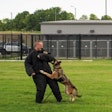With its military pedigree, Reeves' Incident Command Post (ICP) is built to meet military standard requirements for rain, wind, temperature, durability, blackout, and snowload. This generator-powered towed trailer pops out into a soft-walled shelter to serve as a portable command center on the fly.
Interestingly, although its lineage ultimately hails from the armed forces, the idea for the ICP shelter system came via the recreational hunting and fishing market, not directly from the military. Upon seeing how the system had been designed for civilian use, several employees with law enforcement background saw potential in repurposing it for police and set out to make the transition.
"The concept was really to take this lightweight trailer that we had introduced to the outdoor market and retrofit and reconfigure it for a heavy-duty emergency response environment," says Mark Tallo. The former police officer and current military reservist serves as director of domestic preparedness for Reeves' parent company DHS Systems. "We upgraded the axle, tires, the front dolly wheel, and the plate. We went with a bigger generator and we integrated a larger fuel tank system."
Thanks to a high-tech combination of carbon fiber, plastic, and steel, the system can withstand 55mph sustained winds and lightning. Yet it's lightweight enough at around 3,000 pounds that it can be towed by an SUV or truck over rugged terrain, making it more versatile and economical than motor-home-type trailers or those that require a massive dedicated towing vehicle. It can also be airlifted if necessary.
The rear of the trailer, which stands inside of the soft-sided shelter when the system is fully deployed, can be designed to fit any number of purposes. Depending on the intended mission, it can be outfitted with locking weapon storage cabinets, especially important when used as a SWAT command center. The shelters have also been used for EMS and public health response applications. "It's very modular and flexible," says Tallo.
One of the most important aspects of the ICP is that it's capable of functioning independently even in remote areas. Various communications packages are available for keeping in contact with other officers and departments, or agencies can integrate their own equipment. Temperature control ensures a safe environment for all electronics, as well as comfort for the people inside. The ICP also operates for 36 hours straight on its generator without any external power. All models can be deployed within 30 minutes, and most require only two people to set them up.
Even with the ICP's hardiness and off-road capability, some agencies have needed convincing of its benefits. Recently, a potential customer from rural Florida asked Tallo why he shouldn't buy a cheaper trailer and upfit it himself for use in his jurisdiction's rugged areas.
Tallo told him, "I want you to do a comparison of the chassis, durability, axle capacity, tires, wheels, and ground clearance (18 inches on my frame), and see if they're building them as heavy duty as we are." After some research, the man returned convinced. "He's seeking out some funding for it now," says Tallo
Reeves' ICP is available in three different sizes: small with 107 square feet of useable floor space when fully deployed, medium with 161 square feet, and large with 214 square feet, in a price range from $36,000 for the small to $40,000 for the large model. It currently comes with a 6.5-kilowatt gas-fueled generator, but a diesel version will soon also be available.
Visit Reeves Online


















